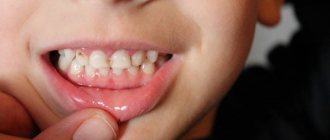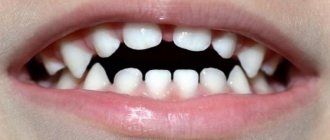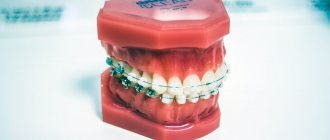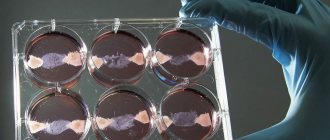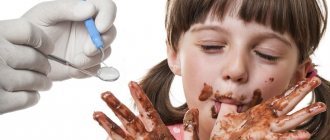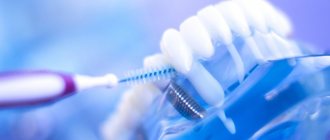Enamel is one of the hardest tissues in the human body. It is continuously exposed to a wide variety of loads: thermal (hot/cold food), chemical and mechanical. Moreover, it is attacked by cariogenic microorganisms. The enamel of baby teeth has a porous structure, it is less dense and durable. After 3 years, children begin to show signs of physiological wear and tear. Destruction of enamel can be a consequence of caries, trauma (chips), development of erosion, enamel hypoplasia and a number of other pathologies. Treatment tactics are selected individually based on the results of the examination. It depends on age, type of bite (temporary or permanent), as well as the individual characteristics of the patient.
Manifestation of dental hypoplasia
Hypoplasia can be systemic or local. In the first case, the entire dentition is affected (the enamel of both milk and permanent teeth is damaged), in the second, one or more permanent teeth are damaged. Local hypoplasia is a consequence of mechanical trauma or an inflammatory process.
Clinical picture of hypoplasia:
- The appearance of white spots on the child’s teeth. Such defects are white (less often yellowish) appear on the outside of the teeth, have a clear contour, and do not cause pain.
- Underdevelopment of enamel. Grooves or depressions appear on the teeth. Pain is usually not noted, but aesthetic defects are very noticeable.
- Lack of enamel (aplasia). A rare manifestation of the disease, the most severe form. The enamel may partially or completely peel off from the teeth, exposing dentin. In such cases, a painful reaction to thermal and chemical irritants is observed.
Causes
To properly treat tooth enamel hypoplasia, you need to understand what caused it. Experts talk about the following reasons:
- due to the fact that mineral metabolism is disrupted, general metabolic processes are disrupted;
- the child has chronic somatic diseases;
- disorders in the brain during the period of 6-12 months, acute infectious diseases, toxic dyspepsia, rickets were diagnosed.
The location of hypoplasia depends on factors such as the severity of the disease that was suffered and the age of the patient.
Treatment methods for enamel hypoplasia in children
If white spots on teeth are invisible to others, they are usually not removed. But the enamel, severely affected by the disease, ceases to protect the tooth tissue, resulting in complications - increased wear of teeth, destruction of dentin up to the loss of teeth, and the appearance of malocclusions. To prevent this, timely therapy is necessary.
Procedures for the treatment of enamel hypopalsia in children:
Restoring enamel on baby teeth
Damage to the enamel of primary teeth can cause the development of dental hypersensitivity. They often violate the aesthetics of the dentition and provoke the rapid development of caries. Restoration of enamel is carried out using filling materials. This method combines simplicity, affordable cost and high efficiency. It allows you to eliminate the existing defect in the enamel layer. The service life of modern composites is several years. This is more than enough when treating baby teeth. It is worth saying that in the presence of foci of enamel demineralization and caries at the stain stage, deep fluoridation of teeth can be carried out. This preventative procedure will help make the enamel stronger and denser.
How to strengthen enamel at home?
To protect the enamel from damage, it is recommended to follow a balanced diet (the diet should contain foods containing calcium - fermented milk products, almonds, hazelnuts, beans, peas, meat, hard cheeses, oatmeal and barley), and take vitamins with calcium.
Special toothpastes (for example, Vivax Dent, Elmex, ApaCare, Lacalut) and gels (ROCS, Amazing White Minerals) are also indicated.
Do not forget that the result of treatment depends on the professionalism of the dentist. On our website you can find a list of clinics that successfully treat this disease.
How to prevent tooth decay
What to do to prevent chipping/decay of teeth:
- ensure high-quality oral hygiene;
- limit the amount of sweets in the children's diet;
- teach your child to brush their teeth and rinse their mouth after eating;
- take your child for preventive examinations to the dentist.
Expectant mothers need to eat well, take vitamins, and treat all their teeth that need it - after all, a child’s teeth are formed in the early stages of pregnancy. Vitamins that a child should receive from food:
- Group A – butter, yolk, offal, fish, fish oil;
- Group D – pork, salmon, yolk, beef liver, fish oil;
- Group E – meat by-products, nuts, seeds, green vegetables;
- Group K – liver, yolk, butter, nuts, seeds, broccoli.
As for babies, it is necessary, if possible, to eliminate night feedings and teach them to drink water at night. You can also use xylitol - containing wipes for treating teeth, if such feedings are still present.
Prognosis and prevention
With adequate treatment, tooth erosion becomes much smaller, and the enamel structure is restored. After severe symptoms disappear, children should visit the dentist regularly to prevent relapse. It is recommended to minimize the consumption of products that can increase the destruction of enamel.
Erosion of tooth enamel can occur even in a child. So that the baby does not experience pain when eating and does not feel embarrassed to smile, you need to consult a dentist in time. Experienced specialists at the SM-Doctor clinic will carry out all the necessary diagnostics and select the optimal way to restore the normal structure of the enamel.
Forms of the disease
It is worth highlighting several forms:
- The color of the enamel of those teeth that were affected changes. This form is considered the easiest, because here the size of the spots is the same, and their boundaries are clearly defined. A child or an adult does not feel any discomfort, there is no pain, and there is no reaction of the teeth to irritants of a thermal or mechanical nature. Also, such stains will not take on the color of the dye;
- the enamel has not fully developed. This form of hypoplasia is already more severe. Grooves, waves, and dots appear here. If you look closely at the surface of the teeth, you can see depressions and grooves of small or medium size. The enamel in them is smooth and dense;
- enamel is completely absent. This form of the disease is also called aplasia, but it is much less common. In some part of the tooth crown there is no enamel at all. A person experiences pain and has difficulty reacting to stimuli of thermal, chemical, and mechanical types.
Why is it better to go to the Aesculapius clinic?
Cooperating with our dentistry is profitable and comfortable. We work with each client on an individual basis and always adapt to the customer's needs. Filling of baby teeth in children in our clinic is performed using the most modern equipment and tools. By contacting us, you get a number of advantages:
- high quality standards;
- responsible approach to work;
- treatment by experienced specialists;
- no queues;
- favorable prices.
You should only trust trusted professionals to fill the root canals of your child’s primary teeth. Only such specialists work in our clinic. During its existence, Esculapius dentistry has already helped hundreds of clients. Filling baby teeth for children in our clinic is safe and reliable. Absolutely all customers are satisfied. Our medical center also installs braces for children and adolescents. Experienced orthodontists have reliable and modern systems for forming a correct bite.
All you need to do to receive quality dental services is make an appointment. Getting to our clinic is very easy. We are located next to the Kyiv metro station, but there are also Studencheskaya and Kutuzovskaya nearby.
If children's teeth are crumbling...
Teeth change color and become extremely sensitive to hot and cold: as soon as children have permanent teeth, many already suffer from so-called molar hypomineralization (MIH).
This is a special form of disruption of the formation of tooth enamel. First of all, this disease affects the chewing teeth. But incisors can also suffer from this disease.
A lack of minerals makes teeth porous. Teeth affected by MIH have fewer minerals present than are present in healthy teeth. First of all, they have a lower concentration of calcium and phosphates. As a result, teeth become porous, and this, in turn, leads to very rapid development of caries.
When affected molars erupt in schoolchildren, molar hypomineralization is now diagnosed quite simply. But just a few years ago the situation was completely different, since this form of diagnosis simply did not exist yet.
The picture of the disease has only recently been described. It was not until 2001 that this phenomenon was brought together under the term Molar Incisor Hypomineralization (MIH), that is, “mineral deficiency in the molars and incisors.”
This approach has significantly improved the diagnosis of children's and adolescent teeth. After all, before this, it was very difficult for the dentist to determine whether the tooth was porous even before the onset of the disease or whether it was a matter of ordinary caries.
Every tenth child has problems with the formation of tooth enamel. Doctors say that the problem of MIH affects ten percent of children, and in five percent it manifests itself in a severe form, accompanied by significantly increased sensitivity and loss of substance.
In adults, it is much more difficult to assess the extent of molar hypomineralization. Even if they had manifestations of MIH, the teeth affected by this disease in most cases have already undergone treatment and restoration, for which reason an appropriate diagnosis is no longer possible.
The causes of MIH should probably be sought in pregnancy. It has not yet been possible to determine where MIH originates from. Doctors admit that they can only guess about the causes of this disease. For example, problems during pregnancy are considered, which could theoretically have a negative impact on dental development.
In addition, events that occur in early childhood, such as high fever infections, antibiotic use and respiratory diseases, as well as dioxin in breast milk, are also suspected. It is possible that the cause of MIH is a combination of several different factors.
Doctors use different methods to treat molar hypomineralization. If MIH is detected in the early stages, the teeth are usually “sealed,” meaning they are coated with a special compound. In more complex cases, fillers and even crowns are used.
Treatment: special dental care, in some cases – removal. In some severe cases of violations of the formation of tooth enamel, the decision remains with the doctors: does a particular tooth have the prospect of long-term preservation? But if a tooth still has to be removed, it should be taken into account that the issue of filling the vacated space must be resolved as soon as possible, since in this case, due to the increased load, neighboring teeth will also suffer.
And you should remember: if children suffer from problems with the formation of tooth enamel, they should brush their teeth only with soft toothbrushes, using fluoride-containing toothpastes.

